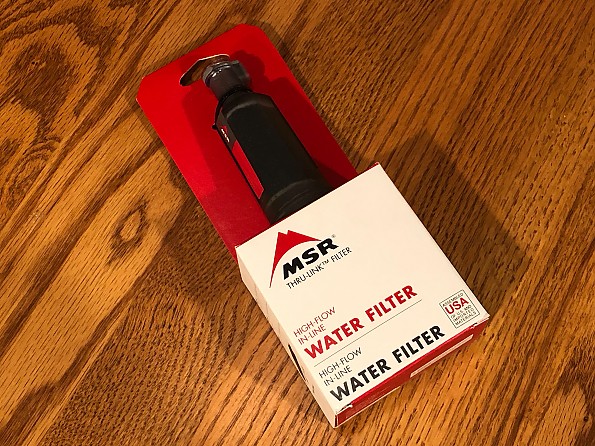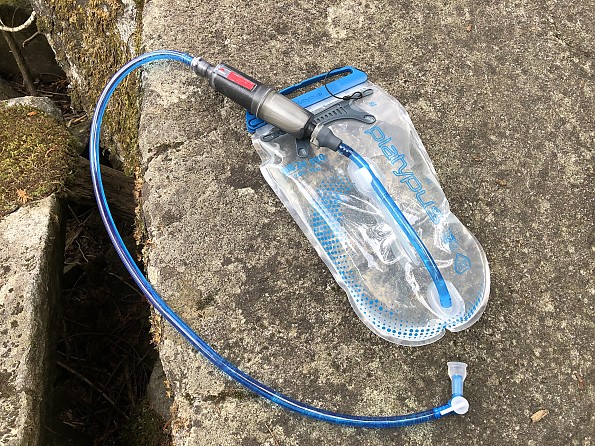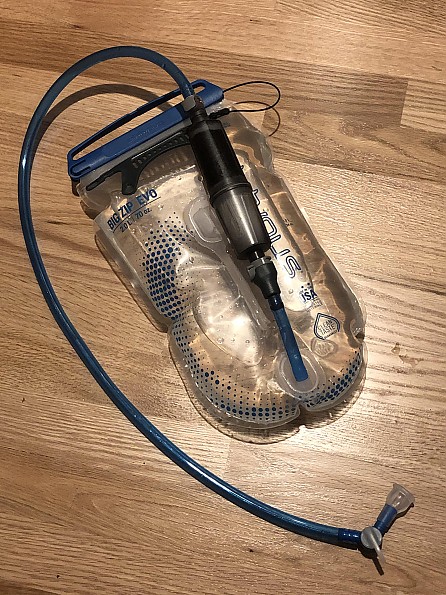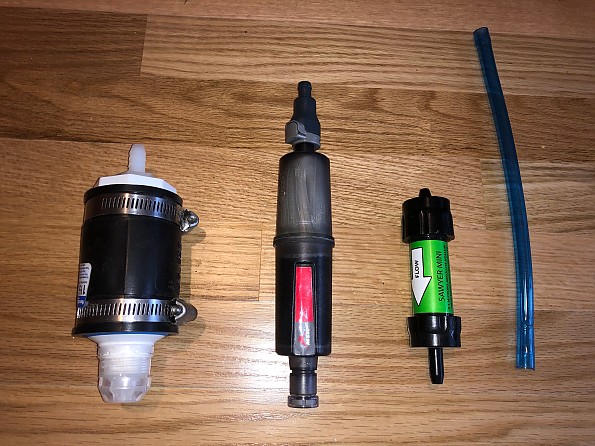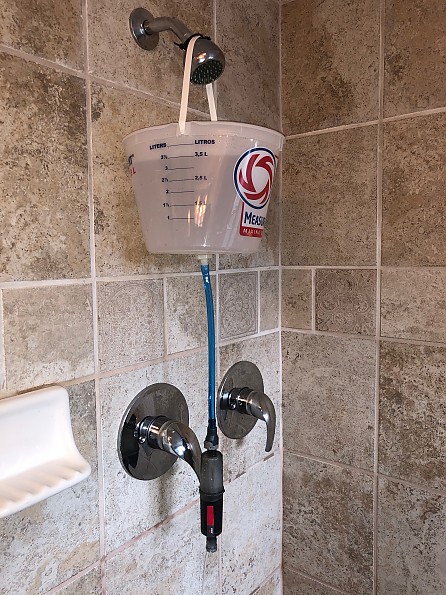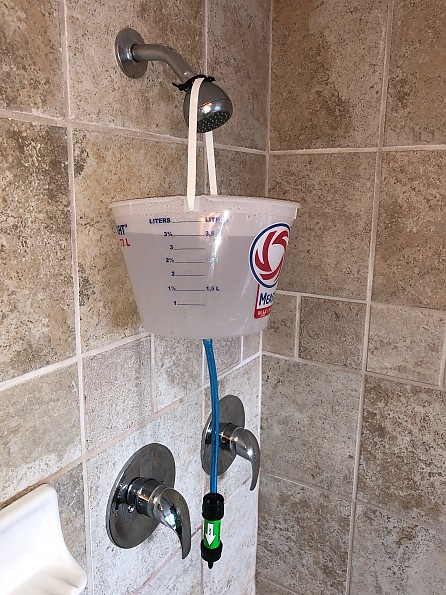MSR Thru-Link

The MSR Thru-Link inline filter is a two-stage water filter design that MSR has been providing to the U.S. military for more than a decade; it became available to the consumer market in spring 2020. The Thru-Link filter is unique in that it is configured to be used in-line with a reservoir/bladder that can be filled with unfiltered water on the go and then your water is filtered as you go along on your hike.
In use, the Thru-Link Filter works well and has very good flow, but depending on how you stow your bladder in your pack, the addition of the Thru-link filter can cause issues with your drinking tube and how it exits the internal cavity of your pack. Overall, I think that the MSR Thru-Link filter is a very good option for someone looking for a robust two-stage water filter that can integrate with their existing hydration system.
Pros
- Solid construction
- Good flow rate
- Quick disconnect is a nice feature when refilling bladder
- Nice that MSR includes connectors for modifying existing bladders to accept filter
- No special tools required for back flushing the filter
- Good online instruction sheet
Cons
- Need clearly stated instructions on the package to flush filter before first use
- Addition of Thru-Link filter can create a potential issue causing pinching of drinking tube depending on how it exits the pack
- You have to go on-line for the instruction sheet—it is less likely someone will actually go look at sheet not included with a product
Overview
While the Thru-Link filter is new to the commercial market as of spring 2020, MSR has been supplying this filter design to the U.S. military for more than ten years. The Thru-Link is a two-stage design consisting of a hollow fiber membrane to remove pathogens and other small particulates combined with an activated carbon element that reduces chemicals, tastes, and odors. The physical packaging of the Thru-Link filter is unique in that it includes fittings at each end of the filter that allows it to be quickly installed or removed from a typical hydration bladder.
Being an in-line filter design, the integration of the MSR Thru-Link filter to a water bladder supports a “scoop and go” approach where in use you would fill your bladder with an unfiltered water source and then your water would be filtered real time as you drink from the bladder through the MSR Thru-Link filter installed along the drinking tube of the bladder.
The Basics of What is Included
The MSR Thru-Link water filter comes packaged as shown in the picture below.
The filter I received for testing was a pre-production item so this packaging was not the final version.
Included in the package I received are the items shown below and consisted of the Thru-Link filter with two male barb fittings. The filter I received was a pre-production version and MSR confirmed that all final production packaging will included both a male and female barb fitting which will enable the user to modify the drinking tube of just about any existing hydration bladder so that it will accept the quick disconnect fittings on the ends of the Thru-Link filter. The fittings that are included will work with any bladder that utilizes tubbing with a 1/4-inch inner diameter.
The filter itself has a translucent housing which is nice as it enables you to see if there is a build-up of debris in the housing and if a cleaning is in order. The plastic housing seems very robust and given that it has been in use by the U.S. Military for over ten years I doubt it will have any problem surviving normal handling and being packed away in your pack.
The MSR Thru-Link is 7-1/2 inches long and approximately 1-5/8 inches in diameter at its widest point. The initial dry weight of the filter is 2.5 ounces, but after the initial use I have found that my drained filter weighs about 4.1 ounces depending on the amount of water retained within the filter elements.
The hollow fiber membrane within the MSR Thru-Link has a pore size of 0.2 microns and is effective in removing bacteria and protozoa along with other small particulates, but is not effective in removing viruses. The activated carbon element can reduce some chemical contaminates like herbicides, pesticides, and other volatile organic compounds, but will not protect you from high chemical concentrations or heavy metal contamination. The reductions that are obtained with the use of the activated carbon element do go a long ways to help improve the tastes, and odors less than ideal water sources.
To use the Thru-Link filter you can either modify your existing bladder utilizing the two fittings included with the filter or if you have a compatible bladder like the Platypus 2L Big Zip EVO shown in the picture below, you can just undo the drinking tube at the quick disconnect and insert the Thru-Link filter like is shown in the picture below.
While assembling the Thru-Link filter to the Platypus Big Zip EVO is very simple and intuitive, there really is one step that you need to do with the Thru-Link filter before your first use that isn’t obvious and you wouldn’t know to do it unless you happened to have looked at the online documentation available on the MSR website. That initial step is to flush the filter to remove loose carbon particles left over during the manufacture of the filter.
Now I wasn’t aware this was needed and didn’t do this before some of my initial testing, so I may have ingested a few bits of carbon, which isn’t a concern at all (and I’m still kicking at this point…), but I think a step like that should be on the actual product packaging so there is a better chance the user would be aware of the need to flush the filter before its initial use.
Observations using the MSR Thru-Link filter
I have been using the MSR Thru-Link filter for several months now during hiking trips here in Western Washington and the filter has performed well. In the time I have been using the filter I have only run into one issue with how the filter impacts the integration/routing of the drinking tube with the primary pack I use.
The integration issue I ran into with using the Platypus 2L Big Zip EVO/Thru-Link combination in my pack, which is a ULA Circuit, is that the drinking tube would sometimes kink when I used the exit feature on the ULA Circuit designed for the drinking tubes coming from bladders stowed in the hydration sleeve of the pack. This wasn’t an issue if I was using the Platypus 2L Big Zip EVO alone without the Thru-Link filter, but when I added in the Thru-Link filter it raises the exit point of the drinking tube from the bladder by 7.5 inches which results in a big bend to get the drinking tube back down to the exit feature on my pack, which at times has resulted in kinking of the drinking tube.
I have tried to show the issue in the picture below, which is looking down into my ULA Circuit.
I have been able to work around this issue, and I could probably easily fix this issue by modifying the location of the female fitting on the Platypus Big Zip EVO, but for someone interested in the Thru-Link filter this is something that they may want to consider depending on the configuration of their pack and internal hydration sleeve.
After a couple of months I finally did modify my Platypus Big Zip EVO by shortening the piece of tubing that the MSR Thru-Link attaches to so that the filter sits lower in my pack and the tubing leaving the exit opening in my pack no longer kinks. Here is a picture showing the modified Platypus Big Zip EVO and MSR Thru-Link filter. It was very simple to do and I am much happier now with the modification.
I have come to really like the quick disconnect fitting that attaches the MSR Thru-Link to the Platypus Big Zip EVO. It's nice to be able to disconnect the filter and hose when you want to refill the bladder as you don't have to mess with pulling the hose back through the opening in your pack as all you have to do is disconnect the filter and then slide the bladder out of your hydration sleeve. The more I use this feature the more I like it.
I'll be doing a separate review on the Platypus Big Zip EVO, but the scoop and go concept does work well in practice as the quick disconnects on the filter combined with the large opening on the Platypus Big Zip EVO makes it quick and easy to refill your bladder during a water break.
The only real issue I have found with the scoop and go approach is that if you have been using this method with questionable water sources, you really need to go back and disinfect your bladder if you plan on using it again without the in-line filter. Doing a good job disinfecting a filter and or bladder is no small task when done correctly, so this is something to consider when adopting the scoop and go approach.
MSR does have a very nice and simple instruction manual that is available on their website here at this link that provides really good information on the use and care of the MSR Thru-Link filter.
Backflushing the Filter
Backflushing is an import task that should be done on a regular basis and the method described in the MSR instruction sheet is a simple backflush that doesn't require any special tools. The method simply involves sucking water through the filter until the tube is full between the filter and the bite valve. The next step is to disconnect the filter from the bladder and then blow back into the bite valve, which pushes water back through the filter to flush out any debris or sediment. I have used the process several times and have found it to be simple and easy and most importantly, something that I could easily get into the habit of doing when using this filter.
Flow Performance
With respect to flow, while there is a noticeable difference between having the filter installed and not installed on the Platypus 2L Big Zip EVO, when the MSR Thru-Link is installed, the flow rate is more than adequate and I am at the point now where I don’t even notice that the filter is installed during normal use.
I wanted to better understand how the flow through the MSR Thru-Link filter compared to other water filters I use, and specifically the Sawyer Mini and the Katadyn BeFree, so I decided to run a test.
On the MSR webpage for the Thru-Link filter, MSR states in the specification section that the Thru-Link filter will flow 1.5 Liters per minute, but they don’t include a reference for the conditions under which the flow rate was measured. Since I was more interested in how the Thru-Link compared to the other filters I owned I decided to create my own test.
The most important variable in this test is with the pressure of the water being supplied to the filter, so I set up my test so the pressure would be consistent when each filter was tested. Here is a picture of the three filters I tested and with the BeFree I had to create a housing for the filter out of some plumbing items to be able to apply a flow of water at a constant pressure to the filter.
And here is a picture with the BeFree filter assembled.
My test setup consisted of a bucket with a fitting in the bottom that I attached a piece of tubing from the Platypus Big Zip EVO and then each filter was attached to the end of the tubing as show in the picture below. While I don’t know what test method MSR used to arrive at their 1.5 L/min flow rate, the test method I am using is representative of how you might filter water in camp on a backpacking trip.
To run each test I would connect a filter to the lower end of the tubing and then adjust the water coming out of the shower head so that the water level in the bucket stayed constant at the 3.5 L mark and there was constant flow through the filter being tested. With this approach each filter would have water supplied at the exact same pressure. For each test, once the flow was constant, I would collect and then measure the water that flowed through the filter over 60 seconds. I ran this test three times for each filter and then used the average for the result.
Here are pictures of the Sawyer Mini and Katadyn BeFree under test.
The table below is the summary of the testing results and you can see that the Thru-Link had the highest flow rate at 365.67 mili liters per minute.
Test Results in ml’s/Minute
MSR Thru-Link BeFree Sawyer Mini
365.67 286.67 134.67
Under my test conditions the MSR Thru-link did not flow 1.5 L/min as indicated in the MSR specifications on their website, but it did have the highest flow rate of the filters I tested. The flow rate is directly a function of the pressure of the water entering the filter and how wetted out the filter is, so I don’t have any reason to believe that the MSR Thru-Link wouldn’t flow 1.5 L/min at a higher pressure then what was created in the simple gravity test I performed, but I do feel my test is representative of real world conditions and reflects the type of flow rate you would actually see in use.
I should also share that my Sawyer Mini is about 3.5 years old and I had to do a number of back flushes before running the final series of tests as it was barely flowing anything when I initially ran it through the test.
The BeFree is the primary filter I have been using for the last two years (and I really like it) prior to receiving the MSR Thru-Link for testing, and the BeFree only flowed about half the final value shown above during some initial test runs before I did a series of back flushes.
So a simple lesson learned from this test is that filters do become clogged with use and it pays to backflush on a regular basis.
To make sure my bucket and hose were not impacting the test results, I did one run without any filter attached to the end of the hose and I measured a flow rate of 4.5 liters a minute which showed that the water wasn’t being restricted in getting to each of the filters under test.
Price
The list price of the MSR Thru-Link filter is $39.95, which I think is a very fair price for a two-stage, robustly designed filter and in line with the cost of similar filters currently available.
Summary and Recommendation
I've found the MSR Thru-Link to be a robust and very well designed water filter that provides very good flow rates and is easy to clean in the field. I also have found the quick disconnect feature of the design very appealing as it greatly simplifies removing your hydration bladder from your pack for refilling. While not really needed for most of the areas I hike in, the activated carbon element within the MSR Thru-Link design is a great feature for those who will be traveling in areas where taste and chemical contamination may also be a concern. Overall, the MSR Thru-Link filter is a great choice for a backcountry water filter.
As a side note, I think that MSR could add a great option to their family of water filters by creating a Thru-Link option (Thru-Link Mini?) without the activated carbon element that would be more compact and lighter and a great option for hikers seeking a lighter more compact in-line filter for areas where pathogens and particulates are the primary concern.
Many thanks to both Trailspace and MSR for the opportunity to evaluate and test the MSR Thru-Link filter for the Trailspace Gear Review Corps!
Background
I have had the MSR Thru-Link filter for four months and have used the filter on regular weekly hikes since receiving it for testing.
I have been using water filters on hiking and backpacking trips for more than twenty years and have owned a variety of filters from an older MSR pump style filter to a Sawyer Mini and a Katadyn BeFree, which has been my go-to filter for the last year or so. Most areas where I use water filters are in the Pacific NW and down in the Sierra where the water is generally of great quality and I only use a filter to protect for pathogens like giardia.
Source: received for testing via the Trailspace Review Corps
(Sample for testing and review provided by MSR)
Your Review
Where to Buy
You May Like
“Have Clean Water Instantly” with the MSR Thru-Link
“Just fill your reservoir by scooping it into a lake or river, and then drink,” said Sarah Courtney, Water Category Manager at MSR, of the Thru-Link. That’s how easy it is for hikers, trail runners, backpackers, and others to stay hydrated with the lightweight (2.5 ounces), in-line microfilter.
Originally designed for and tested for more than a decade by the United States military, the Thru-Link removes bacteria and protozoa and was engineered for fast, high-flow drinking by individuals on the move. It connects quickly to your existing hydration reservoir to be used as an in-line filter; while in camp, it can be set up as a gravity filter.
For outdoor enthusiasts, Courtney says its biggest advantages are its efficacy and safety, speed (1.2 liters per minute), proven history, and universal fit with any reservoir.
“Proven by the U.S. Military for more than a decade, MSR‘s Thru-Link in-line microfilter combines the effectiveness, durability, and speed that minimalists and thru-hikers require in the backcountry," said Courtney.
Backcountry Use
“The Thru-Link is ideal for hikers, backpackers, and any other outdoor recreationalists who need safe drinking water on the move,” said Courtney. “And it is quite versatile on a range of trip profiles,” particularly in North America, where viruses are less common than during international travel. Chlorine tablets can be added to your reservoir before drinking to provide protection from viruses when abroad or otherwise needed.
The Thru-Link features a two-stage filtration chamber and meets the independent NSF Protocol P231 (the standard for microbiological water purifiers) for the removal of bacteria and protozoa.
"With the MSR Thru-Link microfilter, there’s no need for hikers and backpackers to stop and filter their water. They just fill up their reservoir and go," said Courtney. “They have clean water instantly because the Thru-Link filters as they drink.”
First, its fast-flow hollow fiber removes water-borne pathogens (such as protozoa, bacteria, viruses, and multicellular parasites), particulates (such as dirt, sand, and sediment), and microplastics (increasingly found in water sources). Second, activated carbon reduces chemicals, tastes, and odors (including the taste of water reservoirs).
With a compact size of 1.6 by 7.5 inches and weight of 2.5 ounces, it won’t take up much pack space.
The Thru-Link is designed for above-freezing temperatures only. (Note: any water that lingers in the hollow fiber filtration can expand and cause the fibers to burst, compromising the integrity of the filter.)
Design Origins
While the Thru-Link became available to outdoor enthusiasts in 2020, it was originally developed for United States military use starting in 2006. Prior to its development, the U.S. military recognized the need for an individual, on-the-move water filtration system.
“You can imagine the U.S. military’s needs,” said Courtney. “They’re potentially in combat, so they don’t have time to stop and filter water with a pump or gravity filter. Prior to the Thru-Link, water collection and filtration was one of their most vulnerable times.”
A military survey of available commercial, off-the-shelf products found nothing that met their stringent requirements. MSR, which has its own in-house water lab for research, development, and testing, designed the single-pass, drink-through filter to address the technology gap. Since 2006 more than 360,000 Thru-Link microfilters have been used by U.S. servicemen and women.
So, if it worked for the U.S. military, why did it take 14 years for the Thru-Link to be offered to the outdoor public?
"At any given time, our in-house water research laboratory has a large number of filtration and purification technologies at its disposal, but the market’s acceptance of them changes over time" explained Courtney. “We had other water products in the pipeline that we believed would better meet the needs of outdoor users at the time,” like the award-winning Guardian Purifier.
The consumer and military models of the Thru-Link are essentially identical, sharing the same effectiveness, speed, and durability. The only change is an update in the ultrasonic-welded ABS housing to remove a material not compliant with California’s Proposition 65.
As for usage, the military uses chlorine tablets in conjunction with its filters, because they need virus protection internationally. Depending on where you travel, chlorine tablets are not necessary for many hikers and backpackers in North America. However, they can be dropped in your water reservoir after scooping water and before drinking through the filter for an extra level of protection, says Courtney.
Emergency Use
While MSR is an outdoor company, it's working to meet hydration needs not only in the backcountry and in the field, but also during emergencies and in low-resource communities around the world.
The Thru-Link technology is also available in MSR's Emergency Home Water Filtration System, which comes in a hermetically sealed package for long-term storage and fits standard threaded home outdoor spigots and most utility sinks. While using different water treatment technology, the SE200 Community Chlorine Maker helps provide safe drinking water around the world through the company’s Global Health division.
“With large-scale natural disasters on the rise, it is apparent to us that there will be an increasing need for products in water treatment, an area where we have a very high level of technical expertise,” said Courtney. "At the end of the day, nearly all the products that we manufacture serve as survival tools.”
After all, whether you’re climbing your favorite mountains, serving in the military, or running long trails—easy access to safe, clean water remains essential.
Specs
| Price |
MSRP: $39.95 Current Retail: $54.95 Historic Range: $37.39-$54.95 |
| Weight |
2.5 oz / 71 g |
| Dimensions |
1.6 x 7.5 in / 4.2 x 19 cm |
| Flow Rate |
1.5 L per minute |
| Capacity |
up to 1000L |
| Filter media |
Hollow Fiber |
| Filter pore size |
0.2 microns |
| Effective Against |
Bacteria (99.9999%), protozoa (99.9%) and particulate (dirt, microplastics). Meets U.S. EPA drinking water standards and NSF protocol P231 testing standard for removal of bacteria and protozoa. |


